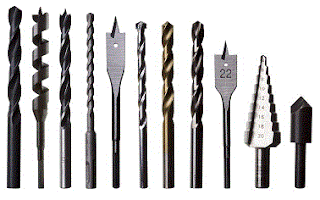 |
| Assorted drill bits |
According to Danielle,
"Drill bits come in a vast array of types, so it's important to know which bit is ideally suited for the task at hand."
"The angle on a drill bit can also vary. Most bits use a 188-degree standard angle, although it is possible to purchase bits with a 135-degree self-centering angle."Really? a 188-degree angle? Surely Smyth didn't think there's a concave face on "standard" bits; did she just blow the copy-reword-paste job from Wikipedia, where the number she cites is actually 118 degrees? And she got the "self-centering" bit backwards: a bit with a 135° tip angle requires a starter hole; self-centering bits have relatively sharper points.
Whatever the case, Danielle did a crappy job of listing the "types," expending the first three-quarters or so of her text on twist bits. It wasn't until the final section of her post that she got around to listing types, telling her readers only that,
"Masonry drill bits, which spiral into a much-harder tip, are great for tasks involving brick or stone. Some drill bits come to a sharp point at the end. Called brad dowell [sic] bits, these are excellent for working with wood. Others, with a wide paddle and sharp center, are called wood spade bits and are ideal for drilling very large holes in wooden materials."
So many words, so little useful information. Feh.
copyright © 2020-2022 scmrak
SE - POWER TOOLS
No comments:
Post a Comment